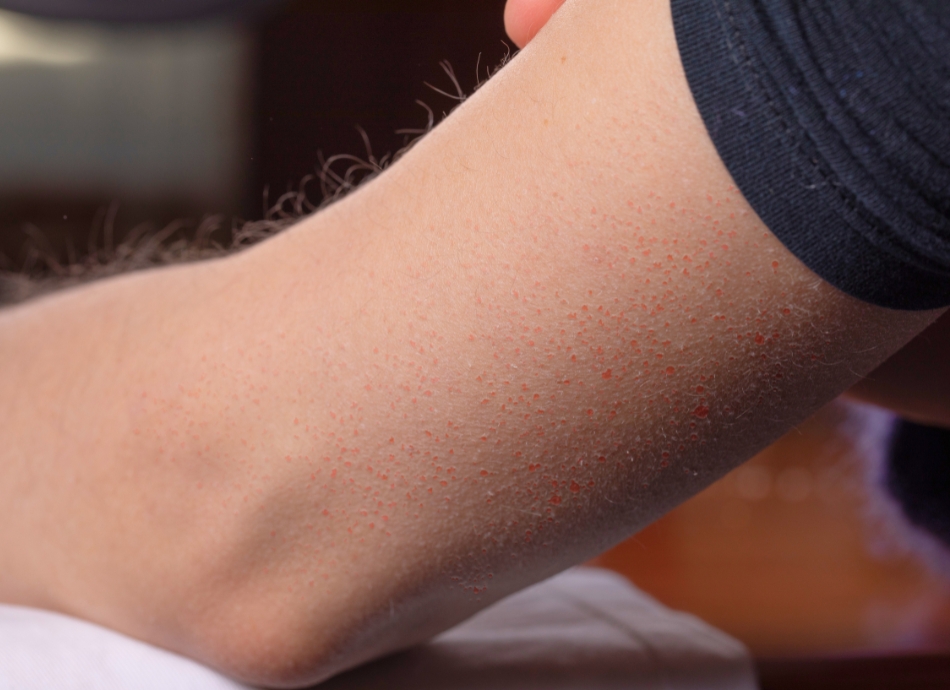Wishing everyone a safe and happy Christmas and New Year – Meri Kirihimete from the Healthify team.
Keratosis pilaris
Say 'ker-uh-toh-sis pill-are-is'
Key points about keratosis pilaris
- Keratosis pilaris is a common, harmless skin condition that causes small, rough bumps on your skin.
- There's no cure for keratosis pilaris but using moisturisers can help you manage it.
- It’s often better in summer and worse in winter.
- Keratosis pilaris often starts when you’re a child, gets more obvious when you’re a teenager, and may disappear when you’re older.

Keratosis pilaris is a harmless skin condition with small, rough bumps on your skin. These bumps are caused by the build-up of keratin (scale) in your follicles, which blocks the openings to them. Keratin is the main protein of the outside layers of your skin, hair and nails, and usually falls off as your skin regenerates.
Keratosis pilaris often starts in childhood and can last for many years, though it usually improves by adulthood. It’s often worse during winter when skin is generally drier.

Image credit: Depositphotos
The exact cause of keratosis pilaris is unknown, but it’s thought to be genetic. It’s associated with other dry skin conditions such as eczema.
Your healthcare provider can usually identify the condition based on how it looks. Very occasionally, a small sample of skin called a biopsy may be taken to rule out other conditions.
The main symptoms of keratosis pilaris include:
- small, rough bumps on your skin, usually on your upper arms, thighs, cheeks, or buttocks
- bumps that are usually the same colour as your skin, but can sometimes be red on lighter skin or brown on darker skin
- dry, rough skin in the affected areas
- mild itching
- redness around the bumps (for some people)
- weak, curled-up hairs inside the bumps.
The bumps can feel like chicken skin or sandpaper when you run your hand over your skin.

Image credit: Dermanonymous via Wikimedia Commons(external link)
While there's no cure for keratosis pilaris, you can manage it and improve the appearance of your skin.
- Use an exfoliating mitt, sponge, or loofah in the shower or bath.
- Use moisturiser as a soap substitute.
- Apply moisturisers regularly, especially after bathing.
- Chose moisturisers containing urea, lactic acid, or alpha-hydroxy acids to soften your skin and reduce keratin build-up.
- Avoid hot showers or baths, as they can dry out your skin.
- Avoid scratching or picking at the bumps.
If your keratosis pilaris is still causing problems despite your self-care, you can discuss the following with your healthcare provider:
- Topical retinoids to promote cell turnover and prevent follicles from becoming blocked.
- Short courses (a few days) of a mild steroid cream for itch when needed.
- Laser treatments that can reduce redness and improve skin texture if the condition is severe.
These treatments are not a cure and will need to be repeated to continue to be effective.
Keratosis pilaris is a chronic condition, but it often improves with age. For many people it improves or goes away completely by adulthood. It’s not harmful to your health and doesn't lead to other skin problems.
Living with keratosis pilaris can sometimes affect your self-esteem, especially as a teenager. If you're concerned, talk to your healthcare provider about treatment options and ways of coping.
Keratosis pilaris(external link) DermNet, NZ
Keratosis pilaris(external link) NHS, UK
Apps
Brochures
Keratosis pilaris(external link) British Association of Dermatologists, UK, 2021
References
- Keratosis pilaris(external link) DermNet, NZ, 2022
- Keratosis pilaris(external link) NHS, UK 2024
- Hwang S, Schwartz RA. Keratosis pilaris – a common follicular hyperkeratosis. Cutis. 2008;82(3):177–180
- Kootiratrakarn T, Kampirapap K, Chunhasewee C. Epidermal permeability barrier in the treatment of keratosis pilaris. Dermatol Res Pract. 2015;2015:205012
Credits: Healthify editorial team. Healthify is brought to you by Health Navigator Charitable Trust.
Reviewed by: Professor Amanda Oakley CNZM, Dermatologist, Health New Zealand Waikato
Last reviewed:





